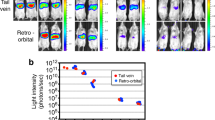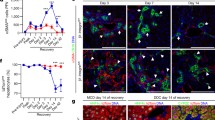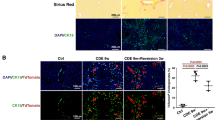Summary
A test system for growth regulators based on the time course of liver regeneration in male NMRI mice injected intraperitonelly (ip) with 50 nmol CC14 at 12 is described. Regenerative DNA synthesis (labelling index) peaked at 36 h after CC14 injury, and the Colcemid-assessed mitotic rate (MR) at 42 h, i.e., 6 h later. This response pattern was used to assess the effects of factors in liver extracts that regulate or modulate hepatocyte proliferation. The effect of one, two, four or eight ip injections of an aqueous mouse liver extract on MR was tested at 48 h. A 30–70% inhibition was seen only after single injections at 12 h, 29 h or 44 h after CCl4 treatment. A 30–80% stimulation was observed after a single injection of the liver extract at 0, 5 or 24 h, and after two or four injections. The assay system could thus detect the presence of growth modulators in the extract. The experiments also showed that the timing was crucial. We recently isolated and characterized a growth inhibitory pentapeptide from mouse liver extracts. Using a synthetic pentapeptide with the same structure we reassessed the timing for growth inhibition seen with the liver extract. The following test system for growth inhibitors seemed most expedient: inhibitor administration at 29 h to affect G1-S transition, measured as reduced DNA synthesis at 36 h, or inhibitor administration at 44 h to affect G2-M transition, measured as reduced MR at 48 h.
Similar content being viewed by others
Abbreviations
- SA:
-
specific activity of DNA
- LI:
-
labelling index
- MR:
-
mitotic rate
References
Astrup EG, Iversen OH (1981) Cell population kinetics in hairless mouse epidermis following a single application of TPA I. Carcinogenesis 2:999–1006
Burton K (1968) Determination of DNA concentration with diphenylamine. Methods Enzymol 12:163–166
Echave Llanos JM (1967) Liver tissue growth factors and circadian rhythms in liver regeneration. In: Teir H, Rytömaa T (eds) Control of cellular growth in adult organisms. Academic Press, New York, pp 209–220
Echave Llanos JM, Moreno FR, Badran AF (1986) Inhibiting effect of plasma from normal and tumour bearing mice on the mitotic rate of regenerating liver. Virchows Arch [B] 52:67–73
Fleig WE, Lehmann H, Wagner H, Hoss G, Ditschuneit H (1986) Hepatic regeneration stimulator substance in the rabbit: relation to liver regeneration after partial hepatectomy. J Hepatol 3:19–26
Hennings H, Elgjo K, Iversen OH (1969) Delayed inhibition of epidermal DNA synthesis after injection of an aqueous skin extract (chalone). Virchows Arch [B] 3:45–53
Iype PT, McMahon JB (1984) Hepatic proliferation inhibitors. Mol Cell Biochem 59:57–80
Liozner IV, Markelova LD (1971) Mitotic cycle of hepatocytes in the regenerating liver. Bull Exp Biol Med 4:445–448
Loginov AS, Speranskii MD, Aruin LI, Matyushina ED, Magnitskii GS (1976) Chalones of liver. Bull Eksp Biol Med 82:1482–1484
McGee JO’D, Patrick RS (1969a) The synthesis of sulphated mucopolysaccharide in mouse liver following carbon tetrachloride injury. I. Autoradiographic studies. Br J Exp Pathol 50:521–526
McGee JO’D, Patrick RS (1969b) The synthesis of sulphated mucopolysaccharide in mouse liver following carbon tetrachloride injury. II. Quantitation and partial characterization of extracted mucopolysaccharide. Br J Exp Pathol 50:527–532
McGee JO’D (1980) The healing response in liver. In: Varieties of healing and their clinical implications. Folia traumatologica. Geigy, pp 13–15
Michalopoulos GK (1990) Liver regeneration: molecular mechanisms of growth control. Faseb J 4:176–187
Paulsen JE (1990) The time-course of mouse liver regeneration after carbon tetrachloride injury is influenced by circadian rhythms. Chronobiol Int 7:271–275
Paulsen JE, Reichelt KL, Petersen AK (1987) Purification and characterization of a growth inhibitory hepatic peptide. Virchows Arch[B] 54:152–154
Paulsen JE, Sundby Hall, Endresen L, Rugstad HE, Reichelt KL, Elgjo K (1991) The peptide pyroGlu-Gln-Gly-Ser-Asn, isolated from mouse liver, inhibits growth of rat hepatoma cells in vitro. Carcinogenesis 12:207–210
Reichelt KL, Elgjo K, Edminson PD (1987) Isolation and structure of an epidermal mitosis inhibiting pentapeptide. Biochem Biophys Res Commun 143:1493–1501
Reichelt KL, Paulsen JE, Elgjo K (1990) Isolation of a growth and mitosis inhibitory peptide from mouse liver. Virchows Arch [B] 59:137–142
Schultze B, Gerhard H, Schump E, Maurer W (1973) Autoradiographische Untersuchung über die Proliferation der Hepatocyten bei der Regeneration der CCl4-Leber der Maus. Virchows Arch[B] 14:329–343
Skraastad Ø (1987) Kidney extract reversibly inhibits compensatory cell proliferation after unilateral nephrectomy. Virchows Arch [B] 53:102–106
Souto M, Echave Llanos JM (1985) The circadian optimal time for hepatectomy in the study of liver regeneration. Chronobiol Int 2:169–175
Zhiqiang Y, Weisong Y, Wenbin Z, Yong C, Fengyi Y (1990) Human hepatic regenerative stimulator substance: partial purification and biological characterization of hepatic stimulator substance from human fetal liver cells. Hepatology 5:1144–1151
Author information
Authors and Affiliations
Rights and permissions
About this article
Cite this article
Paulsen, J.E., Reichelt, K.L. Mouse liver regeneration after carbon tetrachloride injury as test system for hepatic growth regulators. Virchows Archiv B Cell Pathol 62, 173–177 (1992). https://doi.org/10.1007/BF02899680
Received:
Accepted:
Issue Date:
DOI: https://doi.org/10.1007/BF02899680




